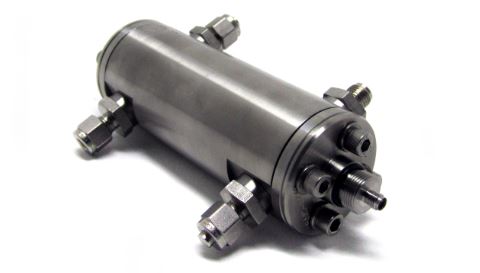Whenever direct insertion probes are inappropriate, and the required optical path length is 30 mm or greater, an Axial Flow Cell is preferred for Process Analytical Technology (PAT) measurements of liquids. The Axial Flow Cell is a convenient, compact, rugged sample interface that is easy to install and even easier to service. Cleanout ports at each window make cell maintenance simple and trouble-free. It is an efficient long path flow cell for process UV-VIS and NIR process spectroscopy (PAT).

Effective For Low Level Detection
High optical throughput and exception stability make the Axial Flow Cell particularly effective in achieving low levels of detection. For example, water levels less than 100 ppm can be routinely measured in organics when the Axial Flow Cell is used with a good quality photometer or spectrometer. Similarly, the lowest APHA color values are easily measured and the onset of yellowness is easily detected.
Flow cell performance strongly affects the overall system performance of a process photometer. High optical efficiency and low sensitivity to environmental factors are essential to sensitive, reliable measurements. Best system performance requires a flow cell that is insensitive to vibration, temperature and pressure changes. Stable performance is especially difficult to achieve when a long-path flow cell is dictated by low limits of detection. The Axial Flow Cell is designed with path-lengths of 30mm to 100 mm with exceptional immunity to environmental conditions.

Resistance to Environmental Influences
The standard Axial Flow Cell is constructed from 316L stainless steel. It can also be made from other materials depending upon specific application requirements, such as Hastelloy C-276. Elastomeric seals prevent leakage and protect the Axial Flow Cell’s vital internal optics. The process and processing environment dictate the actual o-ring material that is best suited for the application. Suitable o-ring materials must be specified to meet your process chemistry and safety requirements. Common materials, such as Viton, Kalrez®, EPDM, etc., are readily available.
Axial Flow Cell with Simple, Serviceable Design Features
- High optical throughput for low noise spectroscopy
- Suitable for liquids and vapors
- Cleanout ports at each window make cell maintenance a snap
- Collimated beam for consistently accurate measurements
- Reproducible pathlength permits servicing in the field
- Compatible with 200 through 600 micron fiber
- 9 mm diameter optics minimize divergence losses
- O-ring sealed optics to prevent ambient moisture infiltration
- Compatible with all fiber optic based UV-VIS-NIR analyzers, according to fiber diameter and spectral range
Axial Flow Cell Pathlengths and Operating Ranges
- Standard Pathlengths: 30, 50, 75, and 100 mm
- Temperature Ranges: -20 °C to 170 °C* limited by the o-ring material
- Pressure Ranges: 0 to 500 psig